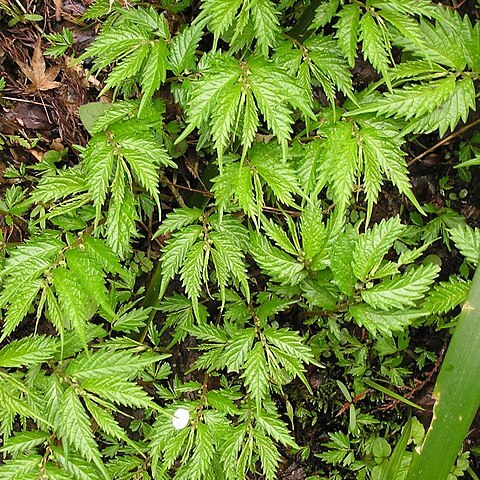Leaves alternate, distichous, sessile or very shortly petiolate, asymmetrical; stipules completely or partly fused, intrapetiolar (however, the presence of vestiges of 2 pairs of stipules indicates that the genus has basically opposite leaves, but one leaf of each pair is rudimentary or totally reduced), stipules of reduced leaf different in size and sometimes also in form from those of extant leaf. Inflorescences unisexual, axillary, sessile (in Flora area), consisting of very densely clustered flowers and surrounded by almost free bracts in the ♂ inflorescences or by somewhat fused bracts in the ♀ inflorescences. Male flowers 4–5-merous, tepals generally with a horn-like dorsal appendage; rudimentary ovary poorly developed or absent. Female flowers with 3–5 very reduced tepals and 3 scale-like staminodes, sometimes sterile; ovary ovoid, with penicillate stigma. Achene ovate, small, ejected by the reflexed staminodes.. Erect annual and perennial monoecious herbs. Stems prostrate and ascending, with the regularly arranged leaves forming flattened aerial shoots. Cystoliths linear
Annual (not in Australia) or perennial herbs or subshrubs, monoecious or dioecious, without irritant (stinging) hairs. Leaves shortly petiolate, distichous, opposite, with one of the pair alternately greatly reduced, or alternate (through the absence or early shedding of the minute opposite leaf of a pair); lamina often asymmetrical and unequal-sided, dentate, sinuate to subentire, usually with cystoliths; stipules intrapetiolar. Inflorescence unisexual, cymose-capitate; flowers in open, discoid or concave often fleshy receptacles surrounded by an involucre of bracts, or in dense axillary cymes. Male flowers: tepals 4 or 5; stamens 4 or 5; pistillode small to minute. Female flowers: tepals 3 or 5, subequal; stigma subsessile, brush-like; staminodes often present. Achenes ellipsoid or ovoid, compressed, often warted. Perianth persistent.
Fls minute, unisexual, in axillary clusters us. subtended by involucral bracts; ♂ with 4-5-partite per., stamens 4-5, inflexed in bud, ovary obsolete; ♀ with per. 0 or of 3-5 minute segs, staminodes us. present, stigmas sessile, penicillate, ovule erect. Achene minute, compressed, ovate to elliptic in outline. Herbs with distichous, alt. or opp., stipulate lvs, of old world tropics and subtropics; the N.Z. sp. endemic.
Leaves distichous, apparently alternate, sessile or very shortly petiolate, asymmetrical; stipules fused, intrapetiolar, (the presence of 2 pairs of stipules indicates that the genus has opposite leaves but one leaf of each pair is rudimentary or totally reduced).
Inflorescences unisexual, axillary, sessile (in the Flora Zambesiaca area), consisting of very densely clustered flowers and surrounded by almost free bracts in the male inflorescences or by somewhat fused bracts in the female inflorescences.
Female flowers with 3–5 very reduced tepals and 3 scale-like staminodes, sometimes sterile; ovary ovoid with a penicillate stigma.
Male flowers 4–5-merous, tepals generally with a horn-like dorsal appendage; rudimentary ovary absent or indistinct.
Achene ovoid, small, ejected by the reflexing of the staminodes.
Erect annual or perennial, monoecious herbs.
Stems prostrate and ascending.
Cystoliths linear.

